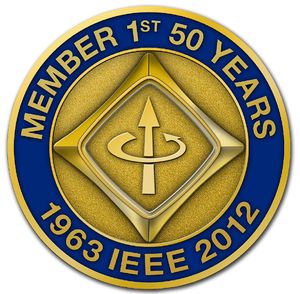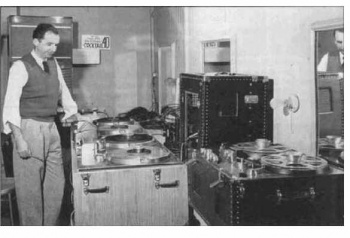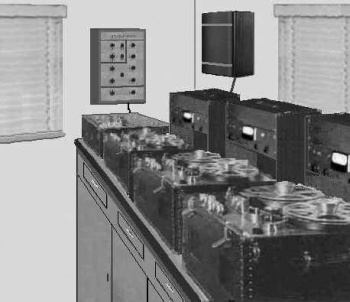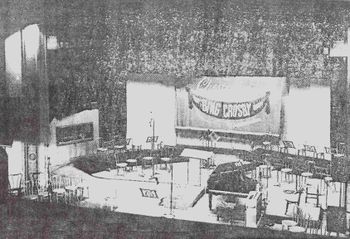First-Hand:The Evolution of the Bing Crosby Radio Show
Contributed by: Robert R. Phillips, Life Member
Editorial comments by: Frontis (Wig) Wiggins, International Club Crosby [4]
Introduction
Over the last several years people have asked me about my association with Bing Crosby and his radio show. One question stands out; it is about the editing of his taped programs. People believed the radio shows were real audience performances that were taped for a later broadcast. However, they observed the same song appearing on different radio programs and even on Decca recordings, and this repeating of material has caused confusion as to how the shows were produced. The real answer is that the radio show evolved over the years as the recording and editing processes improved. I addressed this issue in my First-Hand article, Bing Crosby and the Recording Revolution [1] on the Engineering and Technology History Wiki site, and my presentation to the annual International Club Crosby [2] meeting at Leeds, England in October 2014. However, since the production techniques were a key part of the radio show its evolution deserves a more detailed explanation.
Bing's Radio History
Bing Crosby's radio history covered three decades, and his radio years can be divided into the following major periods:
- Early years began in September 1931 (multiple sponsors)
- NBC Radio's "Kraft Music Hall" (1935-1946) • Bing decided no more live radio shows in 1945
- ABC Radio's "Philco Radio Time" (1946-1949)
- Beginning of recorded radio shows in October 1946
- 1946 season (1946-47) Disk transcription
- 1947 season (1947-48) Modified Magnetophon
- 1948 season (1948-49) Ampex 200 Recorder (First Ampex 300 Spring 1949)
- CBS Radio's "The Bing Crosby Show" (1949-1953)
- Edit facility with three Ampex 300 recorders (Portable Ampex 200 to spring 1951)
- 1949, 1950 and 1951 seasons sponsored by Chesterfield
- 1952 and 1953 seasons sponsored by General Electric (ended in May 1954)
- After the CBS Radio's "The Bing Crosby Show"
- Star of CBS Radio's "The Bing Crosby Show" with Buddy Cole (1954-1956)
- The Ford Road Show (1957-58)
- The Bing Crosby-Rosemary Clooney Show (1960-62)
Each of these periods with their improved recording and editing capabilities permitted changes in the production of the Bing Crosby radio show.
The Early History
The evolution of recorded radio programs began when Bing decided in 1945 that doing live radio shows every week was too demanding on his schedule. He had been doing the "Kraft Music Hall" since 1935 on NBC, and the World War II years showed him that the transcription disk process used for shows broadcast on the Armed Forces Radio Network provided a good alternative to live programs. This technology was developed by the record industry and used by some radio programs. However, NBC on its Red Network had adopted the policy of only presenting live material. The transcription process was used for delayed broadcasts due to the time zones, but never for the original show.
In 1945 Bing requested that NBC record (transcribe) his show with the disk technology so that it could be broadcast at a later time. This process would allow him flexibility in his performance dates. However, when Kraft and NBC would not permit the prerecorded shows, Bing left the show. It caused many problems with both the network and the sponsor. However, he did return to finish the 1945 season on 7 February 1946, but it has been discovered that these last shows were actually recorded on the transcription disks. [5] A check of the recordings also showed them to be edited with audience reactions and selected sections of the program.
This process was employed by the NBC recording staff at their Hollywood studios from where the show originated. They had a major transcription facility in the basement of the building. Since the shows were billed as "live" Bing had to be careful not to be seen at another location. At the end of the 1945 season (Spring 1946) NBC and Kraft decided not to continue with the recorded shows. Bing found a home with ABC (the old NBC Blue Network). The ABC Network was just developing as a separate company and needed good talent such as Bing. During these early years it used the NBC Hollywood studios among others. The same technical facilities also were used for the ABC show as when he was on NBC including the transcription process.
Bing began with ABC in 1946 doing the 30 minute "Philco Radio Time" program in front of an audience, but it was transcribed on 16-inch disks for broadcast at its regular time. Since the radio audience knew it was transcribed, Bing was now free to adjust his schedule so long as the quality of the show was equal to a live radio show. Since a transcription disk could provide excellent quality, this requirement should not have been a problem. These disks have been used to record bandwidths as high as 100 kHz, but the high frequencies fell-off rapidly with each play and the background noise increased. However, the Crosby show decided that improvements needed to be made in the program and began to edit it. This editing process required playing the disk and recording it a number of times. With each transfer of the material, the quality decreased to the point where ABC began to caution the show that they might have to return to live audience broadcasts. For one show over 40 disks were used to produce the final broadcast version.
During the 1946-47 season the producers, advertisers and ABC network executives had many uneasy moments when the final disks were played on the air. Bing also was not happy with the results, but none of them wanted to give up the editing process. However, by the beginning of the 1947-48 season it was decided that if the ratings of the show fell a few more points, the show would have to go to a live broadcast. A search had been going on since early 1947 for an acceptable recording medium, and just before the first show of the 1947 season was to be recorded, Jack Mullin and his modified Magnetophon tape recorders came to the attention of Murdo McKenzie, who was Bing's long time radio producer. Jack gave a presentation to Bing in August 1947, and he was hired to record the first audience show of the season on 10 August 1947. It was a success and was broadcast on 1 October. The "Philco Radio Time" program continued to be a tape recorded audience show for delayed broadcast for the rest of the season. There was one major difference; the show now could be edited without any loss in quality. Bing now had found his freedom.
The Introduction of Tape
There still was one major problem to be overcome: The replacement of the only two modified Magnetophon recorders that were aging and the magnetic tape for them that was rapidly deteriorating due to reuse. Ampex and 3M came to the rescue during the 1947-48 season. Two Ampex 200 recorders and 3M magnetic tape for them were delivered to Jack Mullin in April 1948. The show still needed help in two other areas to allow for the new style into which the Crosby show was going to evolve. One came early in 1948 with the delivery of two "portable" Ampex 200 recorders to replace the original ones (serial numbers 1 and 2) that were in large studio cabinets. The show was now able to travel to other locations where Bing wanted to perform. The other area was the limitation that two recorders placed on the editing process. No dubbing from two different sources could be done. Editing was just limited to cut and paste of the recorded show material. The arrival of the first Ampex 300 recorder in the later part of the 1948 season (1949) now permitted this dubbing to take place as well.
The Evolution
Beginning with the transcription disk process that started in 1946 the editing process for the radio show began to evolve. No one had transcribed and then edited radio shows until Bing decided not to do live broadcasts. The team behind Bing also grew in their ability to adapt the record medium for the radio show. Bill Morrow wrote the show and Murdo McKenzie oversaw its production. When Jack Mullin arrived with his modified Magnetophon tape recorders he was the third member to join the team that was guided by Bing. Bing trusted these people and did not interfere with the product they put together, but he always was in the background encouraging them.
The basic recording process started as an audience show with closed sessions (or rehearsals) using transcription disks. The finished product was an audience radio show with edits that replaced an audience segment with one from the closed session if the audience recording was not as good. It also included editing out offending comments and revising parts needed to bring the show to its assigned time of 30 minutes. Once magnetic tape arrived the editing process became more robust, but the basic material for the ABC Philco years came from the show done before a live audience.
The editing process until the end of the 1948-49 season was still a cutting and splicing operation. However, at times a segue or fade would be tried. This process involved making a long (6 to 8 inches) diagonal cut along the tape. It was difficult to do and made the tape subject to breakage. Another complex edit took place when Truman won the 1948 election. The show was recorded before the election, and Bing said that Dewey had won. This had to be changed, but there was no recorded reference to Truman and Bing was gone! Jack Mullin was able to put together "Truman" from various syllables of Bing's recorded comments to create the missing name. All these edits were of the cut and paste type. The last addition was the beginning of the audience reaction file that grew to include 42 different cuts.
With the start of the 1949-50 season the Crosby show (now on CBS for Chesterfield) moved down Sunset Boulevard to CBS Columbia Square. The show was given its own office and record/edit spaces on the second floor in the east wing of the building. The Crosby show now was a tight knit operation all in one location. The main feature of these facilities was the editing space shown above with its three new Ampex 300 recorders. Jack Mullin designed and built a mixing panel with equalization controls and a control system for keeping the recorder speeds the same. When in Hollywood, the audience show was usually held in the CBS theater at 1615 Vine Street just north of Hollywood Boulevard. The 970 seat theater shown on the left had a reputation for fine acoustics and sightlines and had been used by CBS for many years. Recording sessions without an audience also were done there when it did not interfere with other shows that used the theater; otherwise they were held in one of the CBS Columbia Square studios.
Over time with each recording session began to address more than one radio show. The closed sessions were all day long and usually ended with a show before a live audience that lasted about an hour. The audience session was able to generate material for at least two or three 30 minute radio programs. Bill Morrow wrote the segments to be recorded for multiple shows, and Jack Mullin figured out how to put them together. Murdo McKenzie, the perfectionist, had the job of making sure it all worked to the satisfaction of Bing. He sat on a bar stool behind the editor(s) with his old French taxicab horn that he honked when he wanted to stop the editing process. The sound was turned up in order to hear all the sounds for making an edit cut. The sound at times could be heard outside on the sidewalk below the editing room.
Bing's "Live" Broadcasts (for CBS)
During the last five seasons on CBS the radio show evolved once more from the cut and paste operation into one that was created from many different recording sessions. It again was new territory being explored by the Crosby team. By the time the CBS facilities were set up the show had a library of past recordings indexed and cross referenced by artists, songs, etc. This collection permitted songs to be used from past radio shows and recording sessions, which reduced the time of a recording session needed for a single new radio show. However, as the sessions became less frequent at times they lasted for more than one day. These sessions produced enough material for several different radio shows and were held when it was convenient for Bing's schedule.
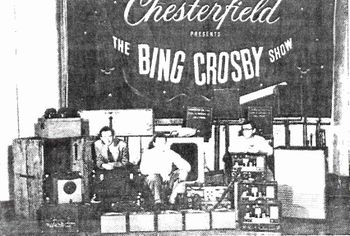
A recording session was closed without any public audience participation. They involved only Bing, guests, the musicians and announcer. Both music and dialogue were recorded during these sessions for use in the radio broadcasts that followed. During his Chesterfield and General Electric years at CBS, Bing did continue to perform shows before live audiences. An example is the Bing and Louis Armstrong and his All Stars at the Marine Auditorium in San Francisco in 1950 and 1951. There was little editing of these shows. The extended periods between the sessions also helped the show when it traveled, giving it more time to move the equipment shown on the right and get it set up. However, the same day long recording session in addition to the live audience show also was used when the show was on the road. The equipment included an Ampex 200 portable recorder until Jack Mullin left the show. He like to use it for editing.
The material from the recording sessions and shows would then be edited into a 30 minute radio program. This edited program would consist of segments from the closed and audience sessions augmented by audience reactions from the tape library.
More Sophisticated Editing
Starting with the 1949-50 season until the end of the General Electric radio show in 1954 most of the shows involved assembling to some degree. There were many parts to an assembled show. While the basic structure of the show may have been done during an audience part of the recording session, the songs were from different sources. If there were past recordings of a guest artist or Bing, it would be very likely that one of the songs would be from the earlier show that featured that guest artist.
Since it could be a week or two from the recording session until a radio show was broadcast, the exchanges between people had to be updated. It was true particularly of the exchanges between Bing and Ken Carpenter, the announcer. Ken would be recorded at the CBS studio, but one had to go to where Bing was located. Sometimes it meant driving to his ranch at Elko, Nevada and having him do his part there. Sometimes a recording of Bing or the guest would be sent in from a distant location if required.
Each radio show would go through several edit sessions with the last one a week before its broadcast. The shows would be put together using the editing guide, and each piece of tape would be numbered. Even the audience reactions were identified. This part also included putting together exchanges between Bing and Ken Carpenter or the guest that were recorded in different locations. These different pieces of tape had to be corrected for acoustics and pitch if required. The pitch correction was done by slowing one tape and speeding up the other. Once the match was made the speed was slowly normalized. The last part of the editing process was to cut it to the broadcast time and adding the audience reactions. The reactions included many different types from full applause to groans. There were even stage and orchestra sounds added at times when these sounds would normally occur in a live production. It was an artistic effort.
Once the editing process was finished the master edit tape was dubbed for backup, and both tapes were then sent to the network for broadcast. Jack Mullin was a perfectionist when it came to the show. It was very difficult to tell where the edits were made even when a person was told the locations. He also instilled this perfection in the people he trained to replace him. Many people have detected the same song appearing in different radio shows, which was due to the reuse of past recordings. A number of the recordings also were transferred to Decca for making records. These recordings also have been identified with ones from the radio programs.
Bill Morrow now had to write several shows at a time along with an editing guide for putting each show together. By the time Jack Mullin left the show in June 1951, it was a smooth running operation; he had worked out a process with Bill, Murdo and Bing to allow for the recording of material for multiple radio shows in one session. These four men wrote the book for editing programs that is still in use today even though the editing is done digitally.
A New Era
At the end of the General Electric broadcast season on CBS in the spring of 1954, Bing decided to end his long running radio program. He dismissed his large orchestra and much of the staff involved in its production. He turned to doing short broadcasts (usually fifteen minutes long) with Buddy Cole and guests. In the end his main guest was Rosemary Clooney, and they did parts of the show usually in her home. These programs were more jazzy in content and used record-over techniques developed by Bing's friend Les Paul. The music was recorded in a studio, and the radio programs were assembled much like the editing used during the years of the General Electric Show.
Epilogue
The radio and recording industry owes much to the evolution of the Bing Crosby radio show between 1947 and 1954. Bing, through his desire to be free of the burden of a live radio show, caused a revolution in radio programming that carried over into television. It also changed how records were produced. Jack Mullin, encouraged by Bing, created the editing process. Bill Morrow was able to see the potential for the edited radio show, and Murdo McKenzie made it all happen.
One can listen to many of the Crosby radio shows at Bing Crosby - The Official Bing Crosby Web Site:
http://www.bingcrosby.com
The Internet Radio has a continual stream of material and the Media Vault has additional programs.
References
1. Bing and the Tape Recorder: http://ethw.org/First-Hand:Bing_Crosby_and_the_Recording_Revolution
2. International Club Crosby main site: http://www.bingmagazine.co.uk/ICC/InternationalClubCrosby.html
3. The ICC Bing Crosby song history by Lionel Pairpoint: http://www.bingmagazine.co.uk/bingmagazine/author.htm
4. Fontis B. (Wig) Wiggins died at age 90 on 29 October 2019. He was one of the foremost authorities on Bing Crosby.
5. Discussions with Bing Crosby Enterprises, 7 November 2019
